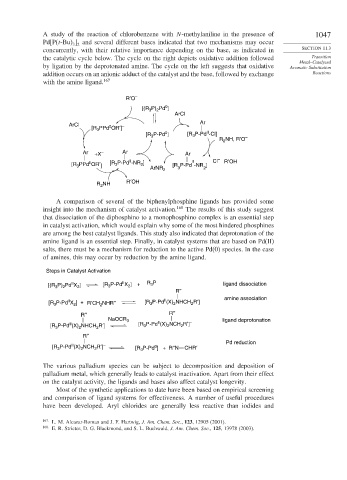Page 1071 - Advanced Organic Chemistry Part B - Reactions & Synthesis
P. 1071
A study of the reaction of chlorobenzene with N-methylaniline in the presence of 1047
Pd[P(t-Bu) ] and several different bases indicated that two mechanisms may occur
3 2
concurrently, with their relative importance depending on the base, as indicated in SECTION 11.3
the catalytic cycle below. The cycle on the right depicts oxidative addition followed Transition
Metal–Catalyzed
by ligation by the deprotonated amine. The cycle on the left suggests that oxidative Aromatic Substitution
addition occurs on an anionic adduct of the catalyst and the base, followed by exchange Reactions
with the amine ligand. 167
R′O –
0
P) Pd ]
[(R 3 2
ArCl
Ar
ArCl 0 –
[R PPd OR′]
3
II
0
P-Pd ] [R P-Pd -Cl]
[R 3 3
R NH, R′O –
2
Ar +X Ar Ar
–
II
II
[R PPd OR′ ] [R P-Pd -NR ] [R P-Pd -NR ] Cl – R′OH
II
2
3
3
ArNR 2 3 2
R′OH
R NH
2
A comparison of several of the biphenylphosphine ligands has provided some
insight into the mechanism of catalyst activation. 168 The results of this study suggest
that dissociation of the diphosphino to a monophosphino complex is an essential step
in catalyst activation, which would explain why some of the most hindered phosphines
are among the best catalyst ligands. This study also indicated that deprotonation of the
amine ligand is an essential step. Finally, in catalyst systems that are based on Pd(II)
salts, there must be a mechanism for reduction to the active Pd(0) species. In the case
of amines, this may occur by reduction by the amine ligand.
Steps in Catalyst Activation
II
II
3
[(R P) Pd X ] [R P-Pd X ] + R P ligand dissociation
3
2
2
2
3
R″
amine association
II
II
[R P-Pd X ] + R′CH NHR″ [R P-Pd (X) NHCH R′]
2
3
2
3
2
2
R″ R″
NaOCR 3 II – ligand deprotonation
II
P-Pd (X) NHCH R′] [R P-Pd (X) NCH R′]
2
2
3
[R 3 2 2
R″
Pd reduction
II
[R P-Pd (X) NCH R′] – [R P-Pd ] + R″N CHR′
0
2
2
3
3
The various palladium species can be subject to decomposition and deposition of
palladium metal, which generally leads to catalyst inactivation. Apart from their effect
on the catalyst activity, the ligands and bases also affect catalyst longevity.
Most of the synthetic applications to date have been based on empirical screening
and comparison of ligand systems for effectiveness. A number of useful procedures
have been developed. Aryl chlorides are generally less reactive than iodides and
167 L. M. Alcazar-Roman and J. F. Hartwig, J. Am. Chem. Soc., 123, 12905 (2001).
168
E. R. Strieter, D. G. Blackmond, and S. L. Buchwald, J. Am. Chem. Soc., 125, 13978 (2003).

